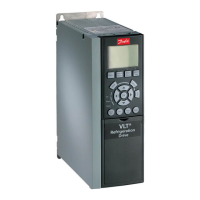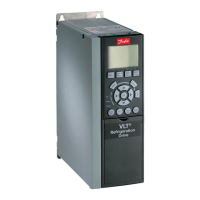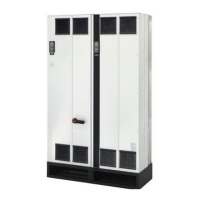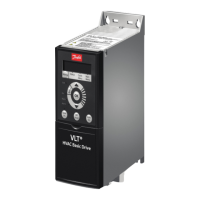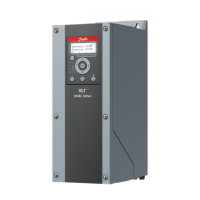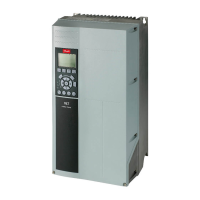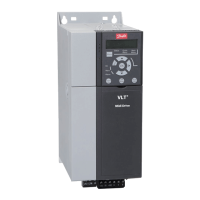5.5 Electrical Kit Installation
This section describes how the electrical kit is used to
connect 2 or 4 drive modules in parallel - to provide
controlled power to an AC motor. A diagram is provided
for each of the 4 congurations which, if followed, meet
specic agency approvals and certications. If designing
and building other congurations, seek agency approvals
or certications apart from Danfoss.
Read this section for guidance in making electrical
connections when assembling the drive modules into a
panel.
5.6 DC Bus Fuse Installation
DC fuses are provided in the basic kit. Install the DC fuses
at the available DC terminals at individual drive modules,
using the recommended bolts. Each DC fuse has a xture
for mounting the microswitches, which are used to detect
a fuse failure. See Illustration 3.3. Install the supplied
harness between the microswitch terminals and the brake
fault jumper port on the top of the drive modules. If the
jumper is not installed properly, the unit does not power
up and the error Brake IGBT Fault is shown. The
microswitch has 3 terminals: NO, NC, and COM. Connect
the wire harness between the NC and COM terminals. If it
is connected between any other terminals, the unit does
not power up, and the error Brake IGBT Fault is shown.
NOTICE
The microswitch is a snap t onto the fuse. Ensure that
the switch is properly installed on the fuses.
5.7 Motor Connections
5.7.1 Motor Cables
See chapter 7.6 Cable Specications for more information on
wire type and sizes.
NOTICE
SHIELDED CABLE LENGTH
With a standard VLT
®
Parallel Drive Modules drive
system, shielded cables up to 150 m (492 ft) long or
unshielded up to 300 m (984 ft) long provide full voltage
at the motor. If this cable length is exceeded, use a
dU/dt lter. For information on the selection of a dU/dt
lter, refer to the VLT
®
Parallel Drive Modules Design
Guide.
5.7.1.1 Voltage Rating
Peak voltages up to 2.8 times the mains voltage of the
VLT
®
Parallel Drive Modules drive system can occur in the
motor cable. High peak voltages can severely stress the
motor cable. Use motor cables with rated voltage speci-
cation of at least 0.6/1 kV. Cables in this range provide
good resistance to insulation breakdown.
5.7.1.2 Dimensions
Follow local codes for current capacity data for cables and
conductors. Widely used codes include: NFPA 70, EN
60204-1, VDE 0113-1, and VDE 0298-4. Overdimensioning
for harmonics is not required.
5.7.1.3 Length
Keep cables as short as possible. Voltage drop and heat
dissipation depends on the frequency and is approximately
proportional to cable length. Consult the cable
manufacturer specications regarding the length and
expected voltage drop when connected to the drive
system. See chapter 7.6 Cable Specications.
5.7.1.4 Shielding
The following factors are important for eective shielding:
•
Make sure that the amount of cable surface
covered by the shield is at least 80%.
•
Use a single-layer braided copper shield. Ensure
that the shield is braided to reduce surface area
for leakage currents.
•
Use cables with double shielding to improve the
attenuation of interference further. Twisted
conductors reduce magnetic elds.
•
Use cables that are shielded at both ends
between the drive system and the motor.
•
To comply with radio frequency interference
limits, shield the cables between the drive system
and the motor at both ends.
•
Ensure that the shield fully surrounds the cable.
•
Route cable glands or cable clamps directly to
the grounding point.
•
Keep connections as short as possible at each
end of the cable.
•
Bridge shield gaps such as terminals, switches, or
contactors by using connections with the lowest
possible impedance and the largest possible
surface area.
NOTICE
TWISTED SHIELD ENDS (PIGTAILS)
Twisted shield ends increase the shield impedance at
higher frequencies, which reduces the shield eect and
increases the leakage current. To avoid twisted shield
ends, use integrated shield clamps. Refer to
Illustration 5.2.
Electrical Installation
VLT
®
Parallel Drive Modules
24 Danfoss A/S © 08/2017 All rights reserved. MG37K302
55
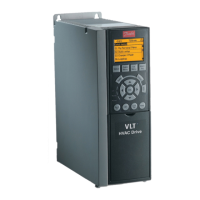
